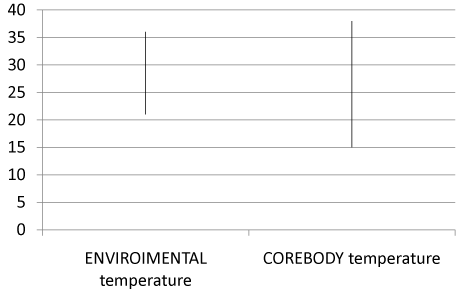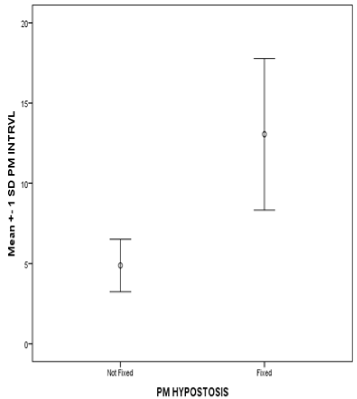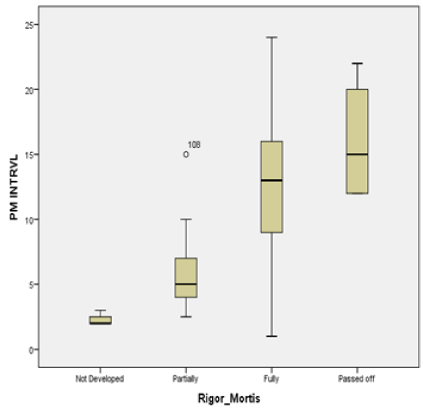
Research Article
Austin J Forensic Sci Criminol. 2015; 2(5): 1044.
Estimation of Early Postmortem Interval by Multiple Regression Analysis
Saralaya PK*, Chandra YPG, Jayanth SH, Praveen S and Krishnan AG
Department of Forensic Medicine, M.S. Ramaiah Medical College, India
*Corresponding author: Pradeep K Saralaya, Department of Forensic Medicine, M.S. Ramaiah Medical College, MSRIT Post, MSR Nagar, Bangalore- 560054, India
Received: April 20, 2015; Accepted: November 20, 2015; Published: November 23, 2015
Abstract
A multiple regression analysis using core body temperature and non temperature based postmortem changes were applied to 204 postmortem cases of within 24h Post Mortem (PM) interval, and non-temperature based postmortem changes like hypostasis and rigidity, were numerically categorized and used with core body temperatures as three statistical variables in the multiple regression analysis. The multiple regression analysis produced a multiple correlation coefficient values for core body temperature multiplication factor is -0.010, rigor mortis multiplication factor is 0.341, and for hypostasis multiplication factor is 0.674, and the constant factor is 0.423. Although assessments of non-temperature based PM changes are mostly subjective and have a wide variation, the present study demonstrated usefulness of non temperature based PM changes in the estimation of PM intervals.
Keywords: Postmortem Interval; Multiple Regression Analysis; Core Body Temperature; Rigidity; Hypostasis
Introduction
Estimation of postmortem interval is an important goal in forensic medicine, the estimation of the time of death, also known as Post Mortem Interval (PMI), is of paramount importance for the police in their investigation when arriving at the scene of a questionable death. A precise determination of a victim’s time of death makes it possible to focus the investigation not only on a narrow time frame, but often also on a narrower range of suspects. This saves valuable time and resources in the critical early stage of the investigation [1]. The aim of the present work was to estimate the time since death using a scoring two postmortem changes; hypostasis, rigidity and analyzing the core body temperature with atmospheric temperature to create a regression equation to narrow down the wide variation in postmortem interval.
Materials and Methods
A one year prospective study was conducted at mortuary, Department of Forensic Medicine M.S. Ramaiah Medical College and teaching hospital Bangalore. Two hundred and four postmortem cases with known PM intervals were selected from the cases autopsied at our institution from the year 2011 to 2012. Clearance from ethical committee was obtained. Cases with known PM interval with in 24 hr are included in the study. Deaths which influence body temperature like drowning, burns, septicemia and early and old age group people are excluded from the study.
The development of rigidity, hypostasis were categorized, and each phase was designated with scores [1-4]. The PM rigidity was categorized into 4 phases according to its development and resolution. The hypostasis was categorized into 2 phases according to its appearance and movement by thumb pressure (Table 1).
Score
Rigor mortis
Post mortem hypostasis
1
Not Developed
Not fixed
2
Partially developed
Fixed
3
Fully developed
4
Passing off
Table 1: Text here.
Environmental temperature was measured by using digital temperature humidity sensor which was placed in the air space near the corpses for at least 5 min before readings. The core body temperature was measured by inserting a thermometer over inferior surface of liver for a 5 min and readings are noted.
Results and Discussion
During the study period, from April 2011 to July 2012, 1216 medico legal autopsies were conducted, of which in 204 cases the exact time of death was known which constitutes 16.7% of the total cases.
Sex distribution
Out of the total 204 cases studied 156 were males and 48 were females, male cases are comparatively more due to (1) male and female ratio in India (2) unnatural deaths more common among males compare to females. In a study conducted by Hoda Fouad Abdel Salam, Eman Ahmed Shaat 70 cases are studied, 58 were males (82.9%) and 12 were females (17.1%) for estimating time since death [2]. In a other study done by Kohji Honjyo Kosei Yonemitsu for estimating time since death Two hundred and twelve postmortem cases (152 males and 60 females) [1].
Season wise distribution
Majority of the cases studied were in rainy season 80 cases followed by 72 cases in winter season and 52 cases in summer. Various factors affected the season wise distribution, among 1216, exact time of death was witnessed only in 204 cases and most cases were kept in cold storage and accurate analysis of season wise distribution was not done. Most of the similar studies conducted were in temperate countries, where there are no much seasonal difference among distribution of cases were noted.
Atmospheric Temperature in Different Seasons
Environmental temperature varied from 21°C to 36°C in Bangalore during the study period (Table 2).
Seasons
Minimum
Maximum
Mean
Summer
19.5
36.2
26.1
Winter
15.1
30.1
21.1
Rainy
19.3
28.1
23.5
Table 2: Text here.
Core body temperature
Core temperature, also called core body temperature is the operating temperature of an organism, specifically in deep structures of the body such as the liver, in comparison to temperatures of peripheral tissues. Core temperature is normally maintained within a narrow range so that essential enzymatic reactions can occur [3]. Postmortem fall of body temperature is due to convection, conduction, radiation and evaporation.
In present study core body temperature varied from 15 to 38oC (Figure 1), peak core body temperature was recorded in case of hanging in the month of April with a postmortem interval of 5hr and the lowest core body temperature recorded in case of coronary heart disease in the month of April with postmortem interval of 14 hr, it states when the postmortem interval advances there is loss of body temperature. In one case of hanging core body temperature was recorded as 42oC, in the month of May with a PMI of 4 hr duration it may be attributed to postmortem caloricity. In a study conducted by Kohji Honjyo, Kosei Yonemitsu for estimating time since death core body temperature varied from 19 to 36.8 degree Celsius and environmental temperature varied from 4 to 31 degree Celsius in Japan [1]. Final inference states that core body temperature starts falling gradually during postmortem interval advances (Table 3).

Figure 1: Text here.
Minimum
Maximum
Environmental Temperature
21
36
Core Body Temperature
15
38
Table 3: Text here.
Postmortem Hypostasis
Livor mortis is the settling of the blood in the lower (dependent) portion of the body, causing a purplish red discoloration of the skin. When the heart stops functioning and is no longer agitating the blood, heavy red blood cells sink through the serum by action of gravity [3]. Among 204 cases studied postmortem hypostasis appeared and not fixed between 4 to 6 hr and fixed between 9 to 16 hr (Figure 2). Postmortem hypostasis is one of the most obvious postmortem changes. In the present study, hypostasis was numerically scored as appeared and not fixed score 1, appeared and fixed score 2. A significant correlation was noticed between hypostasis scores and PMI. Prahlow and Houck and Siegel stated that postmortem hypostasis can be seen as early as 20 min after death, and it was appeared and not fixed between 3-4 h. At the same time, it clarifies the large number of cases it was appeared and fixed between 8-12 h [2]. Bernard knight states that postmortem hypostasis starts to appear after 1 hr and fully established and fixed between 9-11hr [6], Dolinak states that postmortem hypostasis start appear after 3-4 hr and fully established and fixed between 10-12 hr [7], Apurba Nandi states that postmortem hypostasis start appear after 1 hr and fully established and fixed between 5-6 hr [8] (Table 4).

Figure 2: Text here.
Postmortem Hypostasis
PMI
Not Fixed
4-6 hrs
Fixed
9-16 hrs
Table 4: Text here.
Rigor mortis (Latin: rigor “stiffness”, mortis “of death”) is one of the recognizable signs of death, caused by chemical changes in the muscles after death, causing the limbs of the corpse to become stiff and difficult to move or manipulate [3]. In humans, it commences after about three to four hours, reaches maximum stiffness after 12 hours, and gradually dissipates from approximately 24 hours after death. Among 204 cases studied rigor mortis was not developed during first three hours and it started appearing from four to seven hour, and was fully appreciated during nine to sixteen hours and started passing off from twelve to twenty hour (Figure 3). In a study, conducted in Egypt by HodaFouad Abdel Salam a, Eman Ahmed Shaat b, a significant correlation was noted between PMI and rigor mortis. In most cases rigor mortis was partially appreciated between 12 hr, and completely appreciated between 12-24 hr, and start passing off from 24-60 hr. According to Bernard knight rigor mortis start appear ½ hr after death and completely appreciated between 6-12 hr and passing off after 18-36 hr. Dolinak states that rigor mortis start appear 2-3 hr after death and completely appreciated between 8-12 hr and passing off after 12-24 hr. Apurba Nandi states that rigor mortis start appear 2-3 hr after death and completely appreciated between 4-6 hr and passing off after 12-24 hr. There are multiple factors that may affect the onset and time sequence of rigor mortis. In a study conducted by Lorenzo Varetto, Ombretta Curto there is persistence of rigor mortis in 146 corpses kept under refrigeration [4]. Bate-Smith and Bendall documented post-mortem muscle temperature, physical activity, and ante mortem nourishment plays an important role in rigor mortis [5] (Table 5).

Figure 3: Text here.
Rigor mortis
PMI
Not developed
0-3
Partially appreciated
4-7
Completely appreciated
9-16
Passing off
12-20.50
Table 5: Text here.
A Linear (Multiple) Regression Analysis
A linear regression analysis was conducted to estimate the PM interval by using four statistical variables, exact time of death, core body temperatures and scores of two non temperature based PM changes of rigidity, hypostasis. All statistical analyses were performed by using statistical software of SPSS ver. 18.0.
Scores of the two PM changes increased as a function of PM time advances and core body temperature decreases as PM time advances but postmortem staining and Rigor mortis had a wide variation compared to temperature based method.
The equation of multiple stepwise regression analysis of the PMI was obtained using core body temperature and scores of nontemperature based PM changes. We estimated multiplication factors for temperature and non temperature based postmortem changes. For core body temperature multiplication factor is -0.010, rigor mortis multiplication factor is 0.341, and for hypostasis multiplication factor is 0.674, and the constant factor is 0.423.
Y (PMI) = E (0.423-[0.010 × core body temperature]+[0.674 × score of hypostasis]+[0.341 × score of rigor mortis].
Conclusion
Methods of PM interval estimation based on core body temperature are frequently used in forensic assessments. These methods require only a thermometer and possibly a calculator. Those, which use a single measurement of core body temperature, are very simple and can produce a quick estimation.
Non-temperature based PM changes are also widely used for the estimation of postmortem interval by most forensic medical practitioners. We have developed an original table for the assessment of the degrees of non temperature based PM changes and showed their progress as a function of PM time. As was expected, there were great variations in the progress of the three PM changes, which is a result of complex factors of both bodies and environments that influence their progress [1].
Many non-temperature based PM changes such as electrolytes and chemicals in vitreous humour and cerebrospinal fluid, electrical excitability of muscles provide useful information on the estimation of time since death. However, it is not feasible practically to use them at the scene.
Current study was taken up in order to create a simple and accurate method to estimate the time since death by using rigidity, hypostasis and core body temperature, which require no special instruments for the assessment.
Postmortem hypostasis appeared and not fixed between 4 to 6 hr and fixed between 9 to 16 hr. Rigor mortis was not developed during first three hours and it started appearing from four to seven hour, and was fully appreciated during nine to sixteen hours and started passing off from twelve to twenty hour.
Theoretically, the equation obtained from our multiple stepwise regression analysis can be used only in the area where the data has been obtained but not in other places which have a different climate and environmental factors that influence the temperature and nontemperature PM changes. In spite of such limitations, this study demonstrated the usefulness of non-temperature based PM changes in the estimation of PM intervals.
References
- Honjyo k, Yonemitsu k, Tsunenari S. A estimation of early postmortem intervals by a multiple regression analysis using rectal temperature and non-temperature based postmortem changes. Journal of clinical forensic medicine. 2005; 12: 249-253.
- Salam h A, Aziz H A, Shaat EA, Moneim Sheta A, Mohammed Hussan. Estimation of postmortem interval using thanatochemistry and postmortem changes. Alexandria Journal of Medicine. 2012; 48: 335-344.
- Wikipedia-post mortem hypostasis and rigor mortis [Online]. 2014.
- Varetto L, Curto O. Long persistence of rigor mortis at constant low temperature. Forensic Science International. 2005; 147: 31-34.
- Kobayashia M, Takemorib, Yamaguchi M. Differential rigor development in red and white muscle revealed by simultaneous measurement of tension and stiffness. Forensic Science International. 2004; 140: 79-84.
- Knight B. Post-mortem changes of forensic importance. In: Forensic pathology. 2nd edition. 1996; 55-64.
- Dolinak D, Matshes E. Forensic pathology principles and practise. 1st edition. Elsevier: Academic press. 2005; 527-554.
- Nandhi A. Handbook of forensic medicine and toxicology. 1st edition. New central book agency. 2013; 129-171.